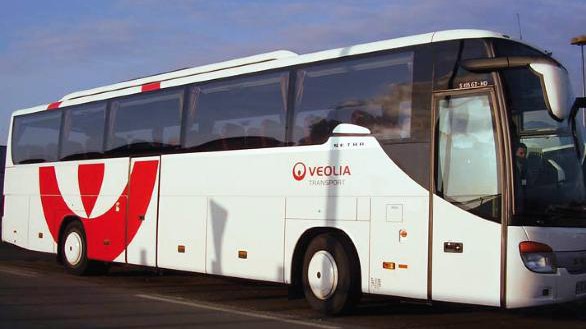TraCE works with Veolia Transport on the future of Nice's mobility

© 2009 ENVIRO2B.COM
TraCE and Veolia Transport Alpes Maritimes have agreed upon a large collaboration framework including two ongoing research projects bearing on the future developments of transportation infrastructure in the region of Nice. The first project, led by Prof. Nikolas Geroliminis of the Laboratory of Urban Transport Systems (LUTS), deals with the analysis and evaluation of the best strategies to improve the Nice-Monaco Veolia bus system, which is confronted to a rapid expansion of its client base. The second project, led by Prof. Vincent Kaufmann of the Laboratory of Urban Sociology (LaSUr), measures the potential for modal shift towards public transport in the greater Nice and constructs typologies of mode choice decisions in order to identify the necessary improvements leading towards a rise in public transport use.
Veolia Transport: "Intelligence in travel", a new concept at the heart of operations
Veolia Transport is the first public transport operator in Europe. Active in 28 countries, the company employs more than 77'000 employees. Its 37'000 vehicles run almost 2 billion trips a year, serving more than 5'000 transit authorities around the world. In France, Veolia Transport employs more than 30'000 people and manages a fleet of 14'000 vehicles.
In 2009, Veolia Transport launched "Bridging the gap : pathways for transport in the post 2012 process", the voice of sustainable mobility in the international climate change negotiations - an initiative in partnership with UITP, TRL, GTZ and ITDP. Committed to environmental solutions that can cope with the fast urbanization of our societies, Veolia Transport has succeeded in reducing its CO2 emissions by 22% and its use of fossil fuels by 23% since 2005. The mobility services provided reduced CO2 emissions globally by 4.3 million metric tons in 2009.
One of the mottos of Veolia Transport revolves around "Intelligence in travel". Innovative solutions include simplified ticketing, costumer mobility centers, Park and Ride solutions, with a special emphasis in the complementarities with shared modes such as bike and car sharing, as well as live information and personalized trip planners.
Veolia Transport Alpes Maritimes is very active in the Nice region, having implemented already several of these innovative solutions, such as simplified ticketing and customer mobility centers, as well as a light rail system that has encouraged a profound facelift of the public spaces within the city. Light rail is also an eco-friendly transit option, as a light rail trip emits 4.61 times less CO2 than the same trip in a private car.
The LaSUr project: typologies of the mobility choices that shape the multimodal city
Given this multimodal context, the research project led by LASUR aims to establish a typology of the different mobility patterns in the Greater Nice, and to identify the potentials for modal shift towards public transport in this area. To better understand the current mobility practices and perceptions of the different transport modes, a thorough analysis of the Household Travel Survey (EMD Nice) will be carried out, that will compare Nice with the other 19 French cities where EMD figures are available, and allow for detailed analyses of key socio-demographic segments of the population that show a higher willingness to engage in a modal shift towards public transport.
The LUTS project: alternative solutions to optimise intercity bus corridors for both commuters and tourists
Veolia Transport Alpes Maritimes also manages an important interurban bus fleet, of which one of the main routes links Nice and Monaco, with 1.5 million passengers per year, including three different kinds of populations: workers living in Nice and working in Monaco, workers living in areas located between Nice and Monaco, and a large number of tourists. Given this context, LUTS has been asked to make an in-depth analysis and evaluation of the present system and the potentials for its future improvement, based on advanced traffic modeling of the three different routes presently used, that present different levels of congestion. The Northern Corridor, highway A8, presents a medium level of congestion, but only two lines of buses run this line, twice hourly. The Southern Corridor, a suburban two-way road by the Mediterranean Sea, knows quite a few bus lines with frequencies of 6-7 minutes, but is plagued with a high level of congestion. A possible alternative, the Middle Corridor, is a suburban road that presents a low level of congestion, but for the moment no public transport line goes through this corridor. The ongoing research project will first make estimations for bus and car travel times for these three routes and will monitor the demand for buses, both for work and leisure-related motives. Then it will model the performance of the current situation, and will simulate the evaluation of new alternatives, such as the introduction of a new line in the Middle Corridor or the adjustment of the frequencies for the lines in the Northern Corridor.
The Marie Curie FP7 project: estimating travel behavior thanks to new information technologies
These two ongoing research projects are part of a larger research agenda that strives to anticipate future trends in transport demand and to identify which key factors may act as leverage to major changes in mobility behavior. Within this larger framework, a Marie Curie EU-FP7 project has been submitted by TraCE in partnership with Veolia Transport Région Méditerranée regarding the estimation of travel behavior thanks to new information technologies such as smartphones. vehicle identification systems and other embedded GPS systems.